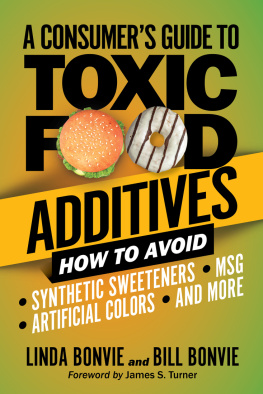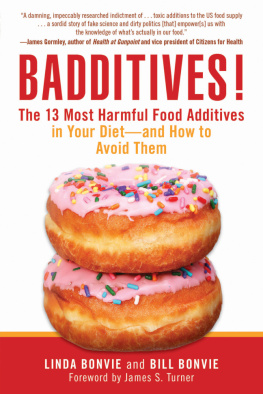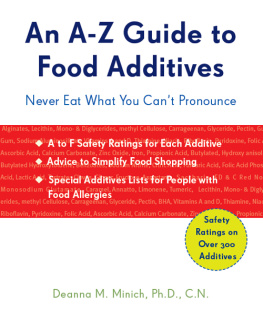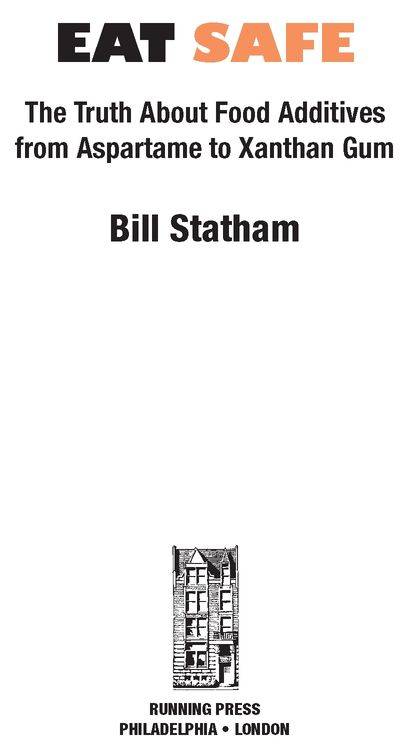Table of Contents
FOREWORD
Both new and experienced safe consumers will benefit from Bill Stathams research and guidance in Eat Safe.
Do not be deceived by its miniature sizethis little handbook could create big changes in the way you look at food and personal care forever. If you take Bills advice to heart, no longer will you be able to participate in mindless shopping expeditions. Ignorance may once have been bliss, but now it spells danger in our mass-manufactured, profit-driven, long shelf-life, chemical-romanced society.
After spending many years researching the toxic ingredients in skin and personal care, and successfully avoiding all of them in the products I create, I am happy to recommend Bill Stathams Eat Safe as an excellent reference guide to anyone questioning the safety of those strange-sounding naturally derived ingredients in their skin and personal care.
Moreover, as a long-term Certified Organic consumer, I truly hope you put your money where your health is, and Go Organic!
Narelle Chenery
Director of Research and Development, Miessence
HOW TO USE YOUR GUIDE
The reference part of this book is divided into two sections.
Section One provides an alphabetical list of food additives that may be found in food products. Section Two provides an alphabetical list of ingredients that may be found in cosmetics and personal care products. Some ingredients are also used as food additives, therefore to avoid unnecessary repetition, they may be found in Section One. Examples are beeswax, bentonite, candelilla wax, and glycerin.
A glossary at the end explains certain terms and abbreviations you may be unfamiliar with (i.e., CNS, surfactant).
A face code shows just how user-friendly each additive/ ingredient is, from safe and/or beneficial through to hazardous.
| 2 happy faces = safe and/or beneficial |
| 1 happy face = safe for most people |
 | 1 quizzical face = caution advised |
| 1 sad face = best avoided |
| 2 sad faces = hazardous |
A system of color coding: red/orange for to be avoided, yellow for wait/caution, and green for proceed safely makes reading the tables even simpler.
Note: The evaluation given is the opinion of the author at the time of writing based on available researched information. This information was referenced from several sources, including but not limited to: Material Safety Data Sheets, animal studies, medical, and scientific laboratory reports.
The codes shown are only a general guide, as individuals react differently to chemical exposures. The type and severity of reaction will depend on many factors. A few of these are: the health of the person, the amounts to which they are exposed and the period of exposure, the environment in which the person lives/works, and the persons age and gender. However, it is recommended that only those products containing additives and ingredients that are safe and/or beneficial or safe for most people as indicated by the happy faces be chosen.
The tables also show some of the benefits of the additive /ingredient and/or some of the detrimental effects, symptoms and illnesses it has the potential to either cause or exacerbate, and some of the environmental effects that may occur.
In most cases the origin of each additive/ingredient is also given, including whether it may be of animal origin or a product of genetic engineering (GE).
Where certain specific medical disorders including cancer, diabetes, tumors, and others are mentioned, only limited reference is made as to whether occurrence was in animals or humans. Also, usually no reference is made to the amounts or concentration of chemicals involved, types of exposure or time periods involved. This information is far beyond the scope of this book, and the reader is directed to the bibliography if they wish to find out more information. The tables also list a few relevant, common consumer products that may contain that particular additive/ingredient, and some other possible uses for it.
Beyond the tables, there is also a section on genetic engineering and, for those who want more information than can be included in a book of this size, a list of useful Internet resources.
DISCLAIMER
Every effort has been made to ensure that the information in this book is accurate and current at the time of publication. The book does not claim to include all information about all chemicals used in foods, cosmetics and personal care products. The author and the publisher disclaim liability for any misuse or misunderstanding of any information contained herein and disclaims liability for all loss, damage or injury, be it health, financial or otherwise, suffered by any individual or group acting upon or relying on information contained herein. The information given should not be construed as medical advice and a qualified health practitioner should be consulted in all cases of ill health.
INTRODUCTION
Like the constant dripping of water that wears away the hardest stone, (the) birth to death contact with dangerous chemicals may in the end prove disastrous. Each of these recurrent exposures, no matter how slight, culminates in the progressive build-up of chemicals in our bodies and so to cumulative poisoning.Lulled by the soft sell and the hidden persuader; the average citizen is seldom aware of the deadly materials with which he is surrounding himself; indeed, he may not realize he is using them at all.
Rachel Carson, Silent Spring (1962)
The idea for this book was born out of a need to understand how some chemicals that are a part of our everyday lives may also play a part in ill health. As a homeopathic practitioner, I often wondered why some of my patients would regain their health under treatment only to relapse later. It was only after some research that I made the connection between what my patients were eatingnot just the types of foods, but also often more significantly the chemical food additives that they containedand their health problems. I also investigated whether there was a possibility that the products they used on their bodies every day, personal care and cosmetic products, could also have a detrimental effect on their health.
What I discovered during my research amazed and often shocked me. I discovered that a significant number of chemicals added to foods and cosmetics could cause or exacerbate health problems such as asthma, dermatitis, hives, migraines, hay fever, gastric upsets, behavioral problems, hyperactivity, learning difficulties, and many others. Some of these chemicals are found to be toxic to body organs and systems like the liver, kidneys, heart, thymus, brain, immune, nervous, hormonal, and endocrine systems. Even more disturbing was the fact that some chemicals permitted in foods, personal care products and cosmetics could also cause damage to DNA, birth defects, genetic mutations, and cancer. I began to tell my patients of my discoveries and encouraged them to eliminate, as much as possible, the chemicals that were found to have detrimental effects on health. As I had expected, the health of my patients improved dramatically and often surprised even the patients themselves.











